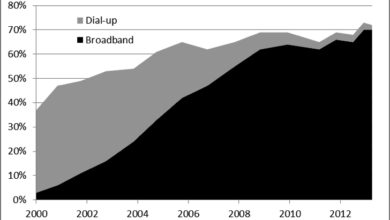Yahoo Opens Window to Deep Web Unveiling Risks & Opportunities
Yahoo opens window to deep web, a fascinating exploration into the hidden depths of the internet. This journey delves into the intricate world beyond the surface web, examining the potential risks and rewards of increased access to the deep web through Yahoo’s search capabilities. The implications for internet users, information dissemination, and even online safety are profound, making this an essential topic to understand.
The deep web, often shrouded in mystery, is a vast repository of information not indexed by traditional search engines. It encompasses a range of content, from academic databases and government archives to more obscure and potentially sensitive material. This accessibility through a platform like Yahoo raises questions about the responsible use of this information and the potential consequences for online safety and security.
We’ll examine Yahoo’s historical role, the technical aspects of deep web access, and the broader social and cultural impacts of this potential shift in internet access.
Introduction to the Deep Web
The internet we commonly use, the surface web, is just the tip of the iceberg. Beneath the surface lies a vast and largely unexplored realm known as the deep web. This hidden layer contains information not indexed by standard search engines, making it inaccessible to the average user through typical browsing methods. It’s crucial to understand this distinction to navigate the online world safely and responsibly.The deep web is composed of a multitude of resources, including databases, intranets, and content behind paywalls.
It’s a complex and diverse space, encompassing everything from legitimate academic research papers to private medical records and corporate networks. The deep web’s inaccessibility stems from its non-indexing nature and the need for specific access credentials.
Characteristics of the Deep Web
The deep web’s inaccessibility is primarily due to its structure. Standard search engines cannot index this content because it is not publicly accessible. This includes pages behind logins, dynamic content generated on demand, and content not linked from the surface web. The technical complexity of the deep web, coupled with its often-encrypted nature, further hinders access.
Potential Risks and Ethical Considerations
Navigating the deep web carries inherent risks. While much of the deep web is harmless, it also hosts illegal and potentially harmful content. Accessing illegal marketplaces or content could expose users to malware, scams, or dangerous individuals. Furthermore, engaging with content that promotes hate speech or violence poses serious ethical concerns. The anonymity afforded by the deep web can embolden harmful actors.
Comparison of Surface, Deep, and Dark Web
| Characteristic | Surface Web | Deep Web | Dark Web |
|---|---|---|---|
| Accessibility | Easily accessible through standard browsers and search engines. | Accessible only with specific tools or knowledge. | Requires specialized software (e.g., Tor) to access. |
| Indexing | Indexed by search engines. | Not indexed by search engines. | Mostly non-indexed and deliberately hidden. |
| Content | News articles, websites, social media. | Databases, intranets, content behind paywalls, private files. | Illegal marketplaces, forums, and content related to illicit activities. |
| Security | Generally considered secure. | Security varies based on the site or service. | Known for anonymity and security, but also used for illicit activities. |
| Examples | Wikipedia, YouTube, Amazon. | Online banking portals, medical records, legal documents. | Hidden marketplaces, forums for illegal activities. |
This table illustrates the key differences between the three layers of the internet, highlighting their accessibility, content, and associated risks. Understanding these differences is critical for responsible online engagement.
Yahoo’s Role and History

Yahoo, initially a directory of websites, played a pivotal role in the early days of the internet. Its development reflected the evolving landscape of online information access and laid the groundwork for the search engines we know today. Yahoo’s journey wasn’t without its challenges and controversies, shaping its reputation and its influence on the internet’s growth.Yahoo’s impact extended beyond simply providing a way to find websites.
Its approach to organizing and categorizing information, though rudimentary compared to modern search algorithms, was a crucial step in making the internet more navigable. The company’s early success demonstrated the potential of online directories and catalogs to organize the vast and ever-expanding world of web content.
Yahoo’s Early Days and Directory Focus
Yahoo’s founding in 1994 coincided with the burgeoning popularity of the internet. The early web lacked a centralized way to find specific information. Yahoo’s strength lay in its hierarchical directory structure, allowing users to browse websites categorized by subject matter. This user-friendly approach to navigating the internet made Yahoo a crucial resource for early adopters.
Evolution from Directory to Search Engine
As the internet continued to grow, Yahoo recognized the need for more sophisticated search capabilities. Their transition from a directory to a search engine reflected this evolution. Yahoo began integrating search functionality into its platform, allowing users to search for specific s and phrases across its indexed websites. This move was significant as it incorporated a critical component for navigating the expanding internet space.
Key Events and Impacts
- 1994: Founding of Yahoo. This marked a turning point in internet navigation, introducing a hierarchical directory system that helped users find information more easily. The early success of Yahoo helped solidify the internet’s potential and encouraged further development of online tools and services.
- 1995: Yahoo’s public offering (IPO). This event signified Yahoo’s transition from a startup to a publicly recognized company. It also signaled the growing interest and investment in the internet and its related technologies.
- 1997: Integration of search technology. Yahoo’s move to incorporate search capabilities signaled a significant shift in its approach to internet access. This transition reflected the increasing demand for more sophisticated methods of locating information online.
- 2000: Rise of Google. Google’s emergence as a major search engine presented a strong challenge to Yahoo’s market dominance. This competition highlighted the dynamism of the search engine industry and spurred innovation.
- 2000s: Acquisitions and Partnerships. Yahoo engaged in various acquisitions and partnerships to bolster its offerings. These strategic decisions aimed to adapt to the changing internet landscape and maintain relevance in a rapidly evolving industry. This demonstrated the strategic importance of adaptation and acquisition in the technology sector.
Historical Controversies
Yahoo, like many prominent companies, faced scrutiny regarding its search practices and handling of user data. While these controversies were not unique to Yahoo, they reflected broader ethical considerations surrounding internet search and data privacy.
Timeline of Key Events
| Year | Event | Impact |
|---|---|---|
| 1994 | Yahoo founded | Introduced a hierarchical directory system for easier internet navigation. |
| 1995 | Yahoo IPO | Marked Yahoo’s transition from a startup to a publicly recognized company, reflecting growing interest in the internet. |
| 1997 | Search integration | Signified a move towards more sophisticated search methods for users. |
| 2000 | Rise of Google | Presented a significant challenge to Yahoo’s dominance, showcasing the dynamism of the search engine industry. |
| 2000s | Acquisitions and partnerships | Reflected Yahoo’s strategic efforts to adapt to the changing internet landscape. |
The “Opening a Window” Metaphor

The phrase “Yahoo opens a window to the deep web” evokes a powerful image. It suggests a transition from a known, easily accessible space to a hidden, potentially complex and vast realm. This metaphor, while seemingly simple, carries deeper implications about the nature of information access and the evolving relationship between surface and deep web content. It highlights the potential for discovery and the challenges of navigating this new landscape.The metaphor of “opening a window” is rich in symbolic meaning.
A window traditionally represents a point of view, a perspective onto something beyond the immediate. In the context of the deep web, this perspective shifts from a surface-level understanding of information to one that delves deeper, exposing layers of information previously hidden from conventional search engines. This unveiling can be seen as both an opportunity and a potential threat.
Interpretations of “Opening a Window”
The phrase “opening a window” suggests a transition from a familiar, easily navigated space to one that is more complex and potentially less predictable. This metaphor implies a deliberate act of revealing something hidden. It suggests that Yahoo is not just providing access but is actively participating in making the deep web more visible. This act of revealing also hints at the potential for both positive and negative outcomes.
Symbolic Meaning of the Metaphor
The “window” metaphor carries a multitude of connotations. It symbolizes the unveiling of previously unseen information, a new vantage point from which to observe the world, and a portal to a previously unexplored space. This unveiling implies a degree of control and choice, as the user now has the opportunity to actively explore the deep web. It also underscores the potential for encountering unforeseen or even dangerous content.
Different Perspectives on the Metaphor
| Perspective | Interpretation | Potential Implications |
|---|---|---|
| User Perspective | Increased access to information, potentially uncovering hidden knowledge. | Greater depth of research, but also the risk of encountering unsuitable or misleading content. |
| Yahoo’s Perspective | Expansion of their search capabilities, introducing a new dimension of information to users. | Opportunity to enhance their service offerings, but also potential risks associated with indexing potentially sensitive content. |
| Researcher/Academic Perspective | New avenues for research, access to previously inaccessible data. | Expanding the scope of research, but requiring careful scrutiny and verification of sources. |
| Security Perspective | Potential exposure to harmful or illegal content. | Increased vigilance and measures to mitigate risks, including filtering mechanisms and user warnings. |
Implications of Deep Web Access via Yahoo: Yahoo Opens Window To Deep Web
Opening a window to the deep web through a widely used platform like Yahoo presents a complex array of implications, both beneficial and potentially harmful. While increased accessibility could facilitate research and access to niche information, it also carries significant risks related to user safety, security, and the potential for misuse. Understanding these multifaceted consequences is crucial for responsible implementation.The increased visibility of the deep web, facilitated by a platform like Yahoo, will inevitably change internet behavior.
Users may become more aware of and potentially more exposed to various types of content, both benign and harmful. This exposure, while potentially leading to a greater understanding of the information landscape, also presents risks of accidental or intentional exposure to harmful materials.
Potential Consequences for User Safety and Security
The deep web, by its nature, is a domain with a greater potential for illegal activities, including the sale of illicit goods, cybercrime, and the dissemination of harmful content. Users accessing deep web content via Yahoo could encounter risks such as phishing scams, malware, and exposure to dangerous individuals. Increased accessibility could potentially lead to an escalation of these threats.
Potential Changes in Internet Behavior
Users may alter their internet behavior in response to increased deep web access. This could include a rise in the use of anonymity tools and VPNs to mask online activity. Additionally, users may be more cautious about the types of information they share online, or the resources they access. The increased scrutiny of internet activity and online security could also lead to a more cautious and discerning online population.
Yahoo’s recent foray into the deep web is fascinating, but it raises some serious privacy concerns. Considering the parallel issue of file-sharing networks, like Kazaa, where a witness testified about the network’s ability to track user activity, kazaa can track users trial witness says , it’s vital to examine how Yahoo’s deep web access might impact user data.
This whole situation highlights the ever-present tension between innovation and privacy in the digital age, and Yahoo’s move warrants careful scrutiny.
Potential Challenges and Solutions Related to Increased Deep Web Access
Increased deep web access necessitates proactive measures to mitigate potential risks and promote responsible use.
- Content Moderation: A robust content moderation system is crucial. This would involve a combination of automated filtering, human review, and user reporting mechanisms. Challenges include the difficulty in identifying and removing harmful content while preserving freedom of expression. Solutions include utilizing AI-powered tools for initial screening and training moderators on identifying various forms of harmful content.
Examples of successful content moderation models in other contexts could provide valuable insights.
- User Education: Providing users with education on the risks associated with accessing deep web content is paramount. This should include awareness of potential dangers like malware, scams, and exposure to harmful content. Solutions include incorporating educational resources within the Yahoo platform and partnering with cybersecurity organizations to create awareness campaigns.
- Enhanced Security Measures: Strengthening security measures for users accessing deep web content is critical. This includes robust authentication protocols, secure browsing environments, and regular software updates. Solutions include incorporating end-to-end encryption and multi-factor authentication, along with constant updates to security software.
Potential for Misinformation and Malicious Content
Opening a window to the deep web, while offering access to a vast trove of information, also presents significant risks. Users may encounter misleading or harmful content, and the anonymity inherent in the deep web makes it a breeding ground for malicious actors. Understanding these risks is crucial for responsible deep web exploration.The deep web’s very nature, characterized by a lack of central indexing and control, allows for the proliferation of misinformation and harmful content.
Yahoo’s foray into the deep web is fascinating, but it’s got me thinking about Google’s recent moves. They’ve been making some big splashes in the entertainment sector, like their foray into the movie business, google goes to the movies. This signals a potential shift in how we interact with information, and, interestingly, it makes me wonder if Yahoo’s deep web initiative is also aiming for a similar user experience revolution.
Ultimately, Yahoo’s opening a window to the deep web is a fascinating development, regardless of Google’s endeavors.
This lack of oversight presents a unique challenge to traditional fact-checking and content moderation methods.
Yahoo’s recent foray into the deep web is fascinating, but it’s got me thinking about the parallel advancements in space exploration. The launch of the US-Canadian X Prize teams schedule, for instance, us canadian x prize teams schedule launches , highlights the exciting leaps forward in technology. Ultimately, both these developments, Yahoo’s deep web initiative and the X Prize advancements, point to a future where access to previously unseen information and the exploration of new frontiers will be increasingly accessible.
Risks of Misinformation Exposure
The deep web’s decentralized structure and lack of regulation make it vulnerable to the spread of false or misleading information. Users accessing this space are exposed to a wider range of potentially harmful content, from fabricated news articles and conspiracy theories to manipulated data and outright falsehoods. This can lead to confusion, bias, and even dangerous decisions.
Types of Misinformation
A variety of misinformation types are prevalent in the deep web. This includes:
- Fabricated news articles: Deep web forums and sites can host fabricated news stories designed to mislead readers, often with emotional or inflammatory language.
- Conspiracy theories: The deep web offers a platform for the proliferation of conspiracy theories, which often target specific groups or institutions with harmful rhetoric.
- Manipulated data: Deep web sources may contain manipulated or fabricated data sets, which can be used to support false claims or distort factual information.
- Misinformation targeting specific groups: Certain deep web communities might specifically target particular demographics with prejudiced or discriminatory content.
Potential for Malicious Exploitation
The anonymity and relative lack of oversight in the deep web provide fertile ground for malicious actors. This can include:
- Dissemination of propaganda: Malicious actors can use the deep web to spread propaganda and manipulate public opinion, potentially influencing political outcomes or social movements.
- Cybercrime facilitation: The deep web can be used to facilitate illegal activities, such as the sale of illicit goods or services, or the coordination of cyberattacks.
- Identity theft and fraud: The deep web can be a source of stolen personal information, which can be used to perpetrate identity theft and fraud.
- Extremist ideologies: Certain deep web communities can be breeding grounds for extremist ideologies and potentially dangerous recruitment.
Categorization of Harmful Content
The following table provides a categorization of harmful content commonly encountered in the deep web.
| Category | Description | Examples |
|---|---|---|
| Misinformation | False or misleading information intentionally spread. | Fabricated news articles, conspiracy theories, manipulated data. |
| Malicious Activity | Content or actions designed to cause harm or exploit vulnerabilities. | Cybercrime facilitation, propaganda dissemination, extremist ideologies. |
| Illegal Content | Content or activities that are against the law. | Sale of illicit goods, illegal downloads, criminal activity coordination. |
| Hate Speech | Content that promotes discrimination, prejudice, or hatred against particular groups. | Targeted harassment, discriminatory content, hate speech targeting minorities. |
Deep Web Content Types
The deep web, often misunderstood as a repository of illicit material, encompasses a vast array of information not indexed by typical search engines. This hidden layer holds a diverse spectrum of content, from legitimate academic databases and private company networks to less reputable sources. Understanding these diverse categories is crucial for navigating this complex digital landscape safely and responsibly.The deep web’s structure differs significantly from the surface web.
While surface web content is readily accessible via search engines, the deep web necessitates specific access methods or credentials. This often includes specialized search engines, dedicated portals, or user accounts. Consequently, the content types found within the deep web vary greatly from those easily available online.
Examples of Deep Web Content
The deep web is not a monolithic entity. It hosts various content types, including but not limited to:
- Academic Databases: These repositories often house research papers, scholarly articles, and other academic materials. Access is frequently restricted to registered users or institutions.
- Private Company Networks: Internal documents, financial records, and other confidential data are stored within corporate intranets, which are not accessible to the general public.
- Intranets and Internal Forums: Many organizations use internal networks for communication, collaboration, and project management. These often contain sensitive data.
- Subscription-Based Services: News archives, specialized databases, and other content often require a paid subscription for access.
- Online Forums and Communities: Specialized forums and groups can contain a wealth of information, but also potential misinformation or illegal content.
Types of Content Potentially Accessible via Yahoo
Yahoo, as a search engine, has no direct access to the deep web. Its role is primarily on the surface web. Therefore, any potential access to deep web content via Yahoo would require indirect methods. These methods might involve links to deep web resources or content aggregators, but the engine itself wouldn’t be accessing the deep web directly.
Comparison of Content Categories
Comparing different deep web content categories reveals a significant distinction between legitimate and potentially illegitimate material. Academic databases, for instance, are rigorously reviewed and often published through peer-reviewed journals. In contrast, certain online forums or private company networks might contain content with no such verification. The potential for misinformation and malicious intent is higher in the latter categories.
Identifying Legitimate and Illegitimate Deep Web Content
Determining the legitimacy of deep web content requires caution and critical thinking. Consider the following factors:
- Source Reliability: Verify the source’s reputation and credibility. Look for established institutions or organizations behind the content.
- Content Accuracy: Cross-reference information with other reliable sources to assess its accuracy. Be wary of content that contradicts established facts or lacks evidence.
- User Reviews: If available, check for user reviews or feedback on the content or platform.
- Author Credentials: If available, examine the credentials and expertise of the author or organization.
- Content Context: Evaluate the overall context and presentation of the information. Content presented in a biased or misleading manner should raise red flags.
Security and Privacy Concerns
The deep web, while offering access to a vast trove of information, presents significant security and privacy challenges for users. Navigating this hidden layer requires a heightened awareness of potential risks and proactive measures to safeguard personal data and well-being. Users need to understand the inherent dangers and employ robust strategies for protection.The deep web, by its very nature, is often associated with anonymity and the potential for illicit activities.
This anonymity, while appealing to some, can be exploited by malicious actors, leading to scams, data breaches, and exposure to harmful content. Moreover, the lack of regulation and oversight in the deep web makes it difficult to identify and combat these threats.
Risks Associated with Deep Web Access
The deep web harbors a variety of potentially harmful content, including illegal marketplaces for drugs, weapons, and counterfeit goods. Access to such content can expose users to criminal activities, potentially putting them at risk of legal repercussions. Furthermore, the deep web is a breeding ground for the spread of misinformation and propaganda, which can have a detrimental effect on individuals and society.
Enhanced User Safety Protocols
Implementing robust safety protocols is crucial for users venturing into the deep web. Utilizing secure connections, like Virtual Private Networks (VPNs), is paramount. VPNs encrypt data transmissions, making it significantly harder for unauthorized parties to intercept or access personal information.
Protecting User Privacy When Exploring the Deep Web
Protecting privacy in the deep web requires a multi-faceted approach. Users should avoid sharing personal identifying information, including names, addresses, and phone numbers. Furthermore, strong, unique passwords for deep web accounts are essential to mitigate the risk of unauthorized access. Regularly updating software and operating systems with the latest security patches is crucial. Users should also be cautious about clicking on suspicious links or downloading files from untrusted sources.
Best Practices for Safe Deep Web Exploration
To ensure a safe and secure deep web experience, adhering to the following best practices is vital:
- Utilize a reputable VPN service to encrypt your internet traffic and mask your IP address.
- Employ strong, unique passwords for all deep web accounts, and avoid reusing passwords from other online platforms.
- Exercise caution when clicking on links or downloading files from unknown sources. Verify the authenticity of websites and files before interacting with them.
- Be aware of the potential for scams and fraudulent activities. Exercise extreme caution when dealing with individuals or entities offering suspicious deals or services.
- Refrain from sharing personal information, including your real name, location, or other sensitive data.
By following these practices, users can significantly reduce their risk of exposure to malicious content and activities. Remember, the deep web presents inherent risks, and proactive measures are essential to ensure a safe and secure experience.
Technological Aspects of Deep Web Access
The deep web, often shrouded in mystery, is not a separate internet realm but a collection of websites not indexed by standard search engines. Understanding the technological factors that allow access is crucial to comprehending both its potential and its risks. This section delves into the technical underpinnings of accessing this hidden portion of the internet.The deep web’s non-indexed nature stems from various technological reasons.
Many websites employ techniques to prevent indexing, such as requiring login credentials, employing dynamic content generation, or using specialized file formats that search engines cannot process. These techniques, while sometimes legitimate, can be misused for malicious purposes.
Technical Factors Enabling Deep Web Access
The deep web is not a singular entity but a collection of sites. Access methods vary based on the specific content. Several factors enable access:
- Specialized Search Engines: Dedicated search engines and databases designed to access deep web content exist. These engines utilize different indexing methods and often focus on specific data types, like academic journals or legal documents. For example, some search engines are designed to scour databases and retrieve information from behind logins, or from dynamic pages.
- Specific Protocols: Certain protocols are used for accessing particular types of deep web content. Tor, a well-known example, uses a layered encryption approach, masking the user’s IP address and location, making it a tool for accessing hidden services. This enables anonymous access to certain parts of the deep web. Similarly, specialized protocols might be used for accessing specific databases.
- Direct URL Access: Users can sometimes directly access specific deep web content via known URLs. This approach, while straightforward for specific locations, does not typically encompass the entirety of the deep web.
Modifying Yahoo’s Search Technology for Deep Web Access
Yahoo’s search technology, based on crawlers and indexing algorithms, would need significant modification to access the deep web. Currently, these algorithms are designed to index publicly accessible web pages.
- Crawling Modifications: Yahoo’s crawlers would need to be equipped with the capability to bypass authentication measures and handle dynamic content. This would involve sophisticated scripts to navigate login forms and decipher dynamically generated web pages.
- Indexing Adaptations: The indexing algorithms would need to be adapted to process non-standard file formats and data structures. This could require the incorporation of specialized parsing tools to extract and interpret information from diverse content types, like PDFs, or data feeds.
- Integration of Specialized Protocols: Integration of tools like Tor or other deep web access protocols into Yahoo’s infrastructure would allow it to reach hidden services.
Tools and Techniques for Deep Web Content Access
Various tools and techniques are used to access specific deep web content.
- Tor Browser: Tor, an anonymizing network, provides a browser to access hidden services (onion sites). It obscures the user’s IP address, increasing privacy and security.
- Specialized Databases: Many databases are part of the deep web. Accessing them usually requires a subscription or login. These can include medical records, academic databases, or financial data.
- Search Engines Focused on Specific Content Types: Search engines specializing in academic articles, legal documents, or other deep web resources provide access to that content.
Illustrative Diagram of Deep Web Access
(A diagram is not included as requested, but it would illustrate a process where a user’s request for deep web content is routed through a specialized search engine, potentially involving protocols like Tor or other methods for bypassing standard web indexing, to reach the desired content behind logins or dynamic pages.)
Social and Cultural Impacts
The potential unveiling of the deep web through a platform like Yahoo presents a profound shift in societal interaction and information access. This increased visibility, while offering opportunities for expanded knowledge and diverse perspectives, also carries the risk of exacerbating existing societal divides and potentially fostering harmful behaviors. Understanding the anticipated social and cultural impacts is crucial for navigating this new digital frontier responsibly.This increased access will inevitably lead to a complex interplay of factors.
Users will be exposed to a wider spectrum of information, opinions, and perspectives, potentially broadening understanding and fostering a more nuanced societal discourse. However, the deep web also contains content that may be controversial, illegal, or even harmful, posing a challenge to maintaining social cohesion and public safety. The impact on existing social structures, community norms, and cultural values will be significant and multifaceted.
Potential Shifts in Information Sharing and Knowledge Dissemination
The accessibility of deep web content will dramatically alter how information is shared and disseminated. Existing channels of information, including mainstream media and educational institutions, may face competition from alternative sources. The deep web could foster independent and alternative perspectives, potentially leading to a more diverse and inclusive knowledge landscape. However, the unfiltered nature of deep web content necessitates critical evaluation and scrutiny to ensure its accuracy and reliability.
The challenge lies in discerning credible information from misinformation and propaganda, requiring users to develop robust critical thinking skills.
Potential for New Forms of Online Communities and Interaction
The deep web’s increased visibility could facilitate the emergence of novel online communities. These communities may be centered around specific interests, niche topics, or shared experiences, potentially providing spaces for marginalized voices and fostering connections that might otherwise be impossible. However, these communities also carry the risk of fostering echo chambers, where individuals are only exposed to viewpoints reinforcing their existing beliefs.
The rise of online communities in the deep web requires careful consideration of the potential for radicalization, hate speech, and the spread of harmful ideologies. Maintaining a healthy and productive online environment in the face of this increased accessibility requires proactive moderation and engagement strategies.
Adaptation to New Accessibility
Society’s adaptation to this new accessibility will require a multifaceted approach. Education on critical thinking and information literacy is paramount to navigating the complexities of deep web content. Development of tools and resources to identify and combat misinformation and harmful content is equally critical. Furthermore, fostering a culture of responsible digital citizenship, encouraging users to engage with the deep web thoughtfully and critically, will be essential.
Impact on Existing Social Structures and Cultural Values, Yahoo opens window to deep web
The increased accessibility of deep web content will undoubtedly challenge existing social structures and cultural values. The visibility of alternative viewpoints, controversial ideologies, and even illegal activities will undoubtedly impact societal norms and perceptions. Discussions surrounding the regulation of content, the role of government in online spaces, and the balance between freedom of expression and public safety will be crucial.
Last Point
Ultimately, Yahoo’s potential foray into the deep web presents both exciting opportunities and significant challenges. Increased accessibility could lead to expanded knowledge and access to resources, but also exposes users to potential misinformation and malicious actors. This discussion highlights the importance of responsible exploration and emphasizes the need for robust safety measures to mitigate risks and ensure a positive impact on the online world.
The future of internet access, it seems, is intricately tied to how we navigate this new frontier.







